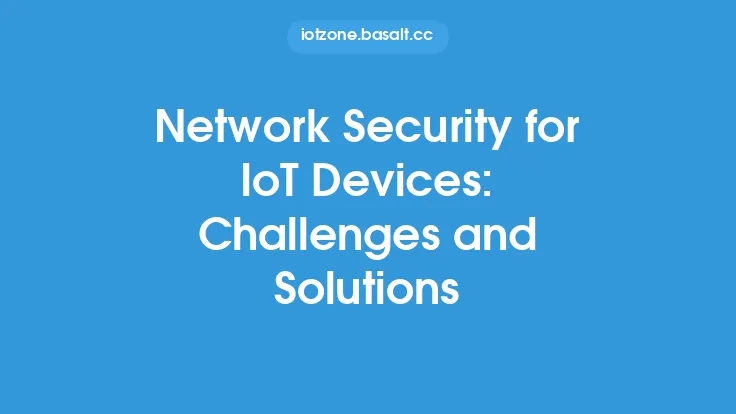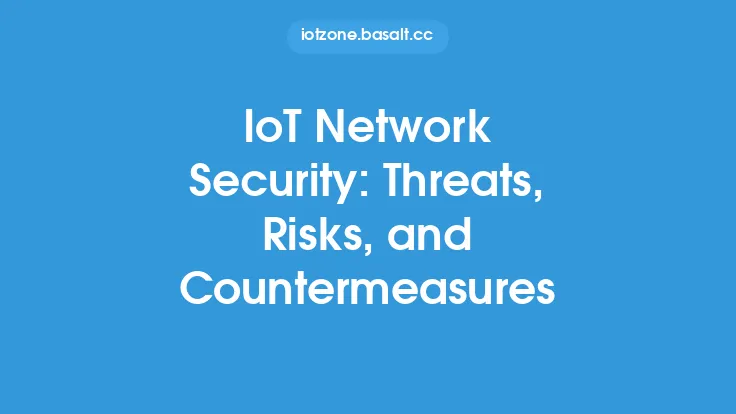The increasing number of Internet of Things (IoT) devices has led to a growing concern about the security of these devices and the networks they connect to. As IoT devices become more prevalent in various industries, including healthcare, finance, and transportation, it is essential to ensure that they are secure and protected from potential threats. One way to achieve this is by implementing network security standards and frameworks that are specifically designed for IoT devices. These standards and frameworks provide a set of guidelines and best practices that can help organizations secure their IoT networks and protect them from potential threats.
Introduction to Network Security Standards for IoT
Network security standards for IoT are designed to provide a set of guidelines and best practices for securing IoT devices and networks. These standards are typically developed by industry organizations and government agencies, and they are designed to be flexible and adaptable to different types of IoT devices and networks. Some of the most common network security standards for IoT include the National Institute of Standards and Technology (NIST) Cybersecurity Framework, the International Organization for Standardization (ISO) 27001, and the Institute of Electrical and Electronics Engineers (IEEE) 802.1x. These standards provide a set of guidelines and best practices for securing IoT devices and networks, including guidelines for authentication, authorization, and encryption.
Network Security Frameworks for IoT
Network security frameworks for IoT are designed to provide a structured approach to securing IoT devices and networks. These frameworks are typically based on industry-recognized standards and best practices, and they provide a set of guidelines and procedures for securing IoT devices and networks. Some of the most common network security frameworks for IoT include the NIST Cybersecurity Framework, the ISO 27001 framework, and the Council on CyberSecurity's Critical Security Controls framework. These frameworks provide a set of guidelines and procedures for securing IoT devices and networks, including guidelines for risk management, vulnerability management, and incident response.
Key Components of Network Security Standards and Frameworks for IoT
Network security standards and frameworks for IoT typically include several key components, including authentication, authorization, and encryption. Authentication is the process of verifying the identity of IoT devices and users, and it is typically achieved through the use of passwords, biometric data, or other forms of identification. Authorization is the process of granting access to IoT devices and networks, and it is typically achieved through the use of access control lists (ACLs) or other forms of access control. Encryption is the process of protecting data in transit and at rest, and it is typically achieved through the use of encryption protocols such as Transport Layer Security (TLS) or Advanced Encryption Standard (AES).
Implementing Network Security Standards and Frameworks for IoT
Implementing network security standards and frameworks for IoT requires a structured approach that includes several key steps. The first step is to conduct a risk assessment to identify potential security threats and vulnerabilities. The next step is to develop a security plan that includes guidelines and procedures for securing IoT devices and networks. The plan should include guidelines for authentication, authorization, and encryption, as well as guidelines for risk management, vulnerability management, and incident response. The final step is to implement the security plan and monitor the security of IoT devices and networks on an ongoing basis.
Benefits of Implementing Network Security Standards and Frameworks for IoT
Implementing network security standards and frameworks for IoT can provide several benefits, including improved security, reduced risk, and increased compliance. Improved security can help to protect IoT devices and networks from potential threats, including hacking, malware, and other forms of cyber attack. Reduced risk can help to minimize the potential impact of a security breach, including financial loss, reputational damage, and legal liability. Increased compliance can help to ensure that IoT devices and networks meet industry-recognized standards and regulations, including the NIST Cybersecurity Framework and the General Data Protection Regulation (GDPR).
Challenges and Limitations of Implementing Network Security Standards and Frameworks for IoT
Implementing network security standards and frameworks for IoT can be challenging and complex, and it requires a significant amount of time, effort, and resources. One of the main challenges is the lack of standardization and interoperability between different IoT devices and networks. Another challenge is the limited resources and budget available for implementing network security standards and frameworks. Additionally, the rapidly evolving nature of IoT devices and networks can make it difficult to keep up with the latest security threats and vulnerabilities.
Future Directions for Network Security Standards and Frameworks for IoT
The future of network security standards and frameworks for IoT is likely to be shaped by several key trends and developments, including the increasing use of artificial intelligence (AI) and machine learning (ML) in IoT devices and networks. AI and ML can help to improve the security of IoT devices and networks by detecting and responding to potential threats in real-time. Another trend is the increasing use of cloud-based security solutions, which can provide a scalable and flexible approach to securing IoT devices and networks. Finally, the development of new security standards and frameworks, such as the NIST Cybersecurity Framework and the ISO 27001 framework, is likely to continue to play an important role in shaping the future of network security for IoT.
Conclusion
In conclusion, network security standards and frameworks are essential for securing IoT devices and networks. These standards and frameworks provide a set of guidelines and best practices for securing IoT devices and networks, including guidelines for authentication, authorization, and encryption. Implementing these standards and frameworks can provide several benefits, including improved security, reduced risk, and increased compliance. However, implementing these standards and frameworks can be challenging and complex, and it requires a significant amount of time, effort, and resources. As the IoT continues to evolve and grow, it is likely that network security standards and frameworks will play an increasingly important role in shaping the future of IoT security.





